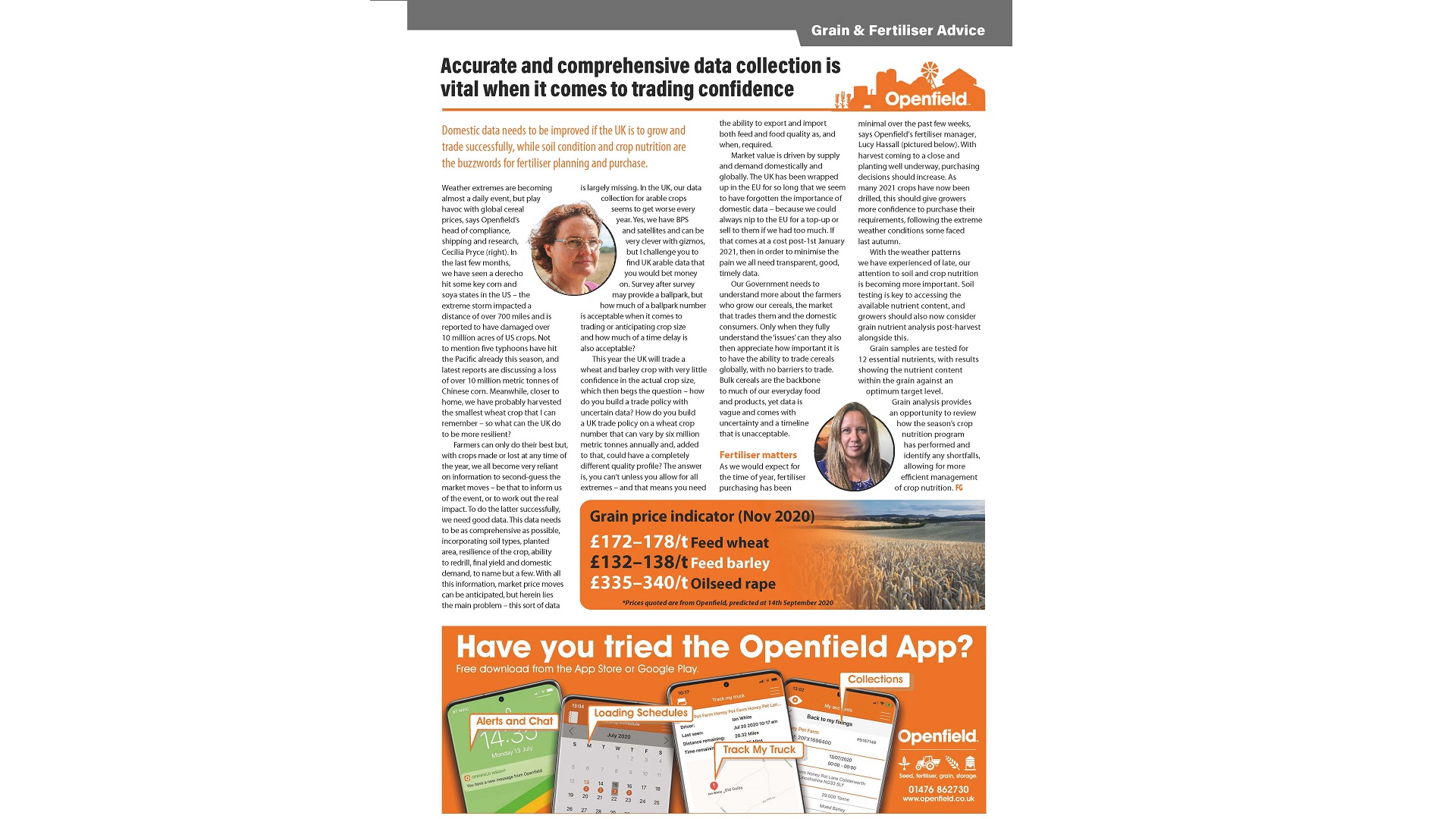Accurate and comprehensive data collection is vital when it comes to trading confidence
Domestic data needs to be improved if the UK is to grow and trade successfully, while soil condition and crop nutrition are the buzzwords for fertiliser planning and purchase.
Weather extremes are becoming almost a daily event, but play havoc with global cereal prices, says Openfield’s head of compliance, shipping and research, Cecilia Pryce. In the last few months, we have seen a derecho hit some key corn and soya states in the US – the extreme storm impacted a distance of over 700 miles and is reported to have damaged over 10 million acres of US crops. Not to mention five typhoons have hit the Pacific already this season, and latest reports are discussing a loss of over 10 million metric tonnes of Chinese corn. Meanwhile, closer to home, we have probably harvested the smallest wheat crop that I can remember – so what can the UK do to be more resilient?
Farmers can only do their best but, with crops made or lost at any time of the year, we all become very reliant on information to second-guess the market moves – be that to inform us of the event, or to work out the real impact. To do the latter successfully, we need good data. This data needs to be as comprehensive as possible, incorporating soil types, planted area, resilience of the crop, ability to redrill, final yield and domestic demand, to name but a few. With all this information, market price moves can be anticipated, but herein lies the main problem – this sort of data is largely missing. In the UK, our data collection for arable crops seems to get worse every year. Yes, we have BPS and satellites and can be very clever with gizmos, but I challenge you to find UK arable data that you would bet money on. Survey after survey may provide a ballpark, but how much of a ballpark number is acceptable when it comes to trading or anticipating crop size and how much of a time delay is also acceptable?
This year the UK will trade a wheat and barley crop with very little confidence in the actual crop size, which then begs the question – how do you build a trade policy with uncertain data? How do you build a UK trade policy on a wheat crop number that can vary by six million metric tonnes annually and, added to that, could have a completely different quality profile? The answer is, you can’t unless you allow for all extremes – and that means you need the ability to export and import both feed and food quality as, and when, required. Market value is driven by supply and demand domestically and globally. The UK has been wrapped up in the EU for so long that we seem to have forgotten the importance of domestic data – because we could always nip to the EU for a top-up or sell to them if we had too much. If that comes at a cost post-1st January 2021, then in order to minimise the pain we all need transparent, good, timely data.
Our Government needs to understand more about the farmers who grow our cereals, the market that trades them and the domestic consumers. Only when they fully understand the ‘issues’ can they also then appreciate how important it is to have the ability to trade cereals globally, with no barriers to trade. Bulk cereals are the backbone to much of our everyday food and products, yet data is vague and comes with uncertainty and a timeline that is unacceptable.
Fertiliser Matters
As we would expect for the time of year, fertiliser purchasing has been minimal over the past few weeks, says Openfield’s fertiliser manager, Lucy Hassall. With harvest coming to a close and planting well underway, purchasing decisions should increase. As many 2021 crops have now been drilled, this should give growers more confidence to purchase their requirements, following the extreme weather conditions some faced last autumn. With the weather patterns we have experienced of late, our attention to soil and crop nutrition is becoming more important. Soil testing is key to accessing the available nutrient content, and growers should also now consider grain nutrient analysis post-harvest alongside this. Grain samples are tested for 12 essential nutrients, with results showing the nutrient content within the grain against an optimum target level. Grain analysis provides an opportunity to review how the season’s crop nutrition program has performed and identify any shortfalls, allowing for more efficient management of crop nutrition.




